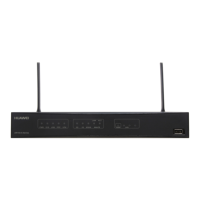Configuration Roadmap
The configuration roadmap is as follows:
1. Create a DDNS policy.
2. Configure the URL for the DDNS server.
3. Set the interval for sending DDNS update requests.
4. Bind a DDNS policy to an interface.
Data Preparation
To complete the configuration, you need the following data:
l Domain name of RouterA
l URL of the DDNS server
l User name and password for the DDNS client to log in to the DDNS server
l Interval for sending DDNS update requests
Procedure
Step 1 Configure RouterA.
# Create a DDNS policy.
<Huawei> system-view
[Huawei] sysname RouterA
[RouterA] ddns policy mypolicy
# Configure the URL of the DDNS server.
[RouterA-ddns-policy-mypolicy] url oray://steven:nevets@phddnsdev.oray.net
# Set the interval for sending DDNS update requests.
[RouterA-ddns-policy-mypolicy] interval 3600
[RouterA-ddns-policy-mypolicy] quit
# Enable DNS resolution.
[RouterA] dns resolve
# Configure an IP address for the DNS server.
[RouterA] dns server 3.1.1.2
# Bind the DDNS policy to Eth1/0/0.
[RouterA] interface ethernet 1/0/0
[RouterA-Ethernet1/0/0] ip address 1.1.1.2 255.255.0.0
[RouterA-Ethernet1/0/0] ddns apply policy mypolicy fqdn www.abc.com
[RouterA-Ethernet1/0/0] quit
After the configuration is complete, when the IP address of Eth1/0/0 changes, RouterA instructs
the DNS server to establish a mapping between the domain name www.abc.com and the new IP
address through the DDNS server. By doing this, users on the Internet can resolve a new IP
address mapping the domain name www.abc.com.
# Configure OSPF.
[RouterA] ospf
[RouterA-ospf-1] area 0
Huawei AR150&200 Series Enterprise Routers
Configuration Guide - IP Service 4 DNS Configuration
Issue 02 (2012-03-30) Huawei Proprietary and Confidential
Copyright © Huawei Technologies Co., Ltd.
101

